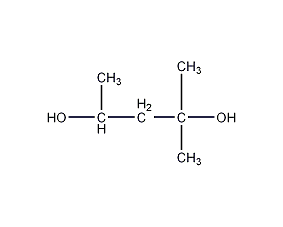
Structural formula
| Business number | 02V8 |
|---|---|
| Molecular formula | C6H14O2 |
| Molecular weight | 118.17 |
| label |
glycol, hexylene glycol, 2-Methylpentyl-2,4-diol, 2-Methylpentane-2,4-diol, 2,4-Dihydroxy-2-methylpentane, Hexylene Glycol, Methyl amylene glycol, a,a,a’Trimethyltrimethyleneglycol, Pinakon, dry cleaning agent, car brake fluid, Printing ink, pigment dispersants, wood preservatives, medical disinfectant, alcohol solvents, Penetrant for fabrics, Paper and leather processing aids |
Numbering system
CAS number:107-41-5
MDL number:MFCD00004547
EINECS number:203-489-0
RTECS number:SA0810000
BRN number:1098298
PubChem number:24897349
Physical property data
1. Properties: Colorless, transparent and slightly sweet liquid.
2. Boiling point (ºC, 101.3kPa): 197
3. Boiling point (ºC, 6.67kPa): 125
4. Boiling point (ºC, 1.33 kPa): 94
5. Melting point (ºC, glassy): -50
6. Relative density (g/mL): 0.925
7. Relative vapor density (g/mL, air=1): 4.1
8. Refractive index (n20D): 1.427
9. Viscosity (mPa·s, 100ºC): 2.6
10. Viscosity (mPa·s, 20ºC): 34.4
11. Viscosity (mPa·s,-1.1ºC): 220
12. Viscosity (mPa·s,-25.5ºC): 4400
13. Flash point (ºC, opening): 93
14. Heat of evaporation (KJ/mol): 81.2
15. Specific heat capacity (KJ/(kg·K), 20ºC, constant pressure): 1.84
16. Critical temperature (ºC): 400
17. Critical pressure (MPa): 3.43
18. Vapor pressure (kPa, 20ºC): 0.0027
19. Body expansion coefficient (K-1): 0.00078
20. Solubility: can be mixed with water,Miscible with high-grade alcohols, ethers, various aromatic hydrocarbons, aliphatic hydrocarbons, etc. Dissolve rosin, dammar resin, nitrocellulose, natural resin, etc.
21. Relative density (20℃, 4℃): 0.925
22. Relative density (25℃, 4℃): 0.919
23. Normal temperature Refractive index (n20): 1.4277
24. Refractive index at room temperature (n25): 1.426
Toxicological data
1. Acute toxicity: Rat oral LD50: 4760mg/kg
2. It is of low toxicity. Prolonged contact with skin may cause irritation and may be absorbed through the skin. When consumed in large quantities, it can stimulate the central nervous system, causing vomiting, fatigue, lethargy, difficulty breathing, renal congestion and bleeding, fatty lesions of the liver, urinary obstruction, bronchitis, pneumonia and even death. The olfactory threshold concentration is less than 241.5mg/m3, and the maximum allowable concentration in the workplace is 125mg/m3 (United States).
Ecological data
This substance is slightly hazardous to water.
Molecular structure data
1. Molar refractive index: 32.84
2. Molar volume (cm3/mol): 123.0
3. Isotonic specific volume (90.2K ): 296.8
4. Surface tension (dyne/cm): 33.8
5. Dielectric constant:
6. Dipole moment (10-24cm3):
7. Polarizability: 13.01
Compute chemical data
1. Reference value for hydrophobic parameter calculation (XlogP): 0.3
2. Number of hydrogen bond donors: 2
3. Number of hydrogen bond acceptors: 2
4. Number of rotatable chemical bonds: 2
5. Number of tautomers: none
6. Topological molecule polar surface area 40.5
7. Number of heavy atoms: 8
8. Surface charge: 0
9. Complexity: 68.9
10. Number of isotope atoms: 0
11. Determine the number of atomic stereocenters: 0
12. Uncertain number of atomic stereocenters: 1
13. Determine the number of chemical bond stereocenters: 0
14. Number of uncertain chemical bond stereocenters: 0
15. Number of covalent bond units: 1
Properties and stability
1. Avoid contact with strong acids, strong oxidants, strong reducing agents, acid chlorides, and acid anhydrides. Flammable liquids. Easily absorbs moisture and is non-corrosive to metals. Similar to ethylene glycol, it is stable to alkali and does not decompose when boiled with sodium hydroxide. In the presence of acid, it is easy to undergo a condensation reaction with aldehydes to generate 1,3-dioxane derivatives.
2. Exist in burley tobacco leaves and smoke.
Storage method
Stored in a cool, ventilated warehouse. Keep away from fire and heat sources. They should be stored separately from oxidants, reducing agents, acids, and food chemicals, and avoid mixed storage. Equipped with the appropriate variety and quantity of fire equipment. The storage area should be equipped with emergency release equipment and suitable containment materials.
Synthesis method
Diacetone alcohol is obtained by condensation of acetone, and then obtained by liquid phase hydrogenation.
The purification method is to dissolve 2-methyl-2,4-pentanediol with 1% sodium hydroxide, heat it at 140℃ for 1 hour, and then perform vacuum distillation below 140℃.
Purpose
Used in organic synthesis. Used as pesticide stabilizer, diesel engine oil antifreeze, etc. 2-Methyl-2,4-pentanediol has permeability and good dispersing ability for inorganic substances. In addition to being used as a solvent, it is also used in dry cleaning agents, automobile brake fluids, printing inks, pigment dispersants, wood preservatives, etc. Used as solvents, spices, medical disinfectants, penetrating agents for fabrics, papermaking and leather processing aids.


